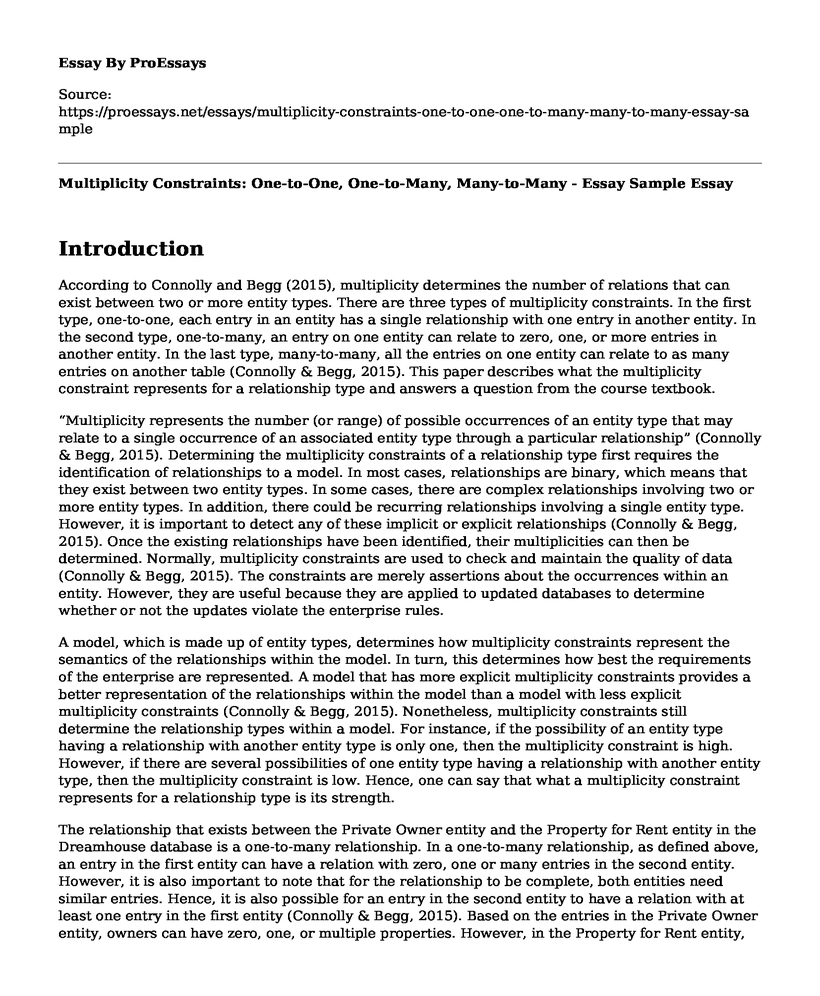Introduction
According to Connolly and Begg (2015), multiplicity determines the number of relations that can exist between two or more entity types. There are three types of multiplicity constraints. In the first type, one-to-one, each entry in an entity has a single relationship with one entry in another entity. In the second type, one-to-many, an entry on one entity can relate to zero, one, or more entries in another entity. In the last type, many-to-many, all the entries on one entity can relate to as many entries on another table (Connolly & Begg, 2015). This paper describes what the multiplicity constraint represents for a relationship type and answers a question from the course textbook.
“Multiplicity represents the number (or range) of possible occurrences of an entity type that may relate to a single occurrence of an associated entity type through a particular relationship” (Connolly & Begg, 2015). Determining the multiplicity constraints of a relationship type first requires the identification of relationships to a model. In most cases, relationships are binary, which means that they exist between two entity types. In some cases, there are complex relationships involving two or more entity types. In addition, there could be recurring relationships involving a single entity type. However, it is important to detect any of these implicit or explicit relationships (Connolly & Begg, 2015). Once the existing relationships have been identified, their multiplicities can then be determined. Normally, multiplicity constraints are used to check and maintain the quality of data (Connolly & Begg, 2015). The constraints are merely assertions about the occurrences within an entity. However, they are useful because they are applied to updated databases to determine whether or not the updates violate the enterprise rules.
A model, which is made up of entity types, determines how multiplicity constraints represent the semantics of the relationships within the model. In turn, this determines how best the requirements of the enterprise are represented. A model that has more explicit multiplicity constraints provides a better representation of the relationships within the model than a model with less explicit multiplicity constraints (Connolly & Begg, 2015). Nonetheless, multiplicity constraints still determine the relationship types within a model. For instance, if the possibility of an entity type having a relationship with another entity type is only one, then the multiplicity constraint is high. However, if there are several possibilities of one entity type having a relationship with another entity type, then the multiplicity constraint is low. Hence, one can say that what a multiplicity constraint represents for a relationship type is its strength.
The relationship that exists between the Private Owner entity and the Property for Rent entity in the Dreamhouse database is a one-to-many relationship. In a one-to-many relationship, as defined above, an entry in the first entity can have a relation with zero, one or many entries in the second entity. However, it is also important to note that for the relationship to be complete, both entities need similar entries. Hence, it is also possible for an entry in the second entity to have a relation with at least one entry in the first entity (Connolly & Begg, 2015). Based on the entries in the Private Owner entity, owners can have zero, one, or multiple properties. However, in the Property for Rent entity, one can have zero or one property only.
As discussed above, multiplicity represents the number of possible occurrences in an entity that may be related to a single occurrence in another entity. Before a multiplicity constraint is determined, the existing relationships between entity types have to be identified. Models with more explicit multiplicity constraints represent their relationships in a better way. These multiplicity constraints differ depending on the strength of a relationship. Also, as discussed, the relationship between the Private Owner entity and the Property for Rent entity is a one-to-many relationship. Private owners can have many properties but individuals in the Property for Rent entity can only have zero or one property.
References
Connolly, T. M., & Begg, C. E. (2015). Database systems: A practical approach to design, implementation, and management. Pearson Education.
Cite this page
Multiplicity Constraints: One-to-One, One-to-Many, Many-to-Many - Essay Sample. (2023, Aug 01). Retrieved from https://proessays.net/essays/multiplicity-constraints-one-to-one-one-to-many-many-to-many-essay-sample
If you are the original author of this essay and no longer wish to have it published on the ProEssays website, please click below to request its removal:
- Research Paper Sample: Google's Culture and Organizational Structure Attributes to Its Success
- Theoretical Firewalls Essay
- The Support of the Stakeholders and the Implementation Process of Evidence-Based Practice
- Enterprise Content Management Implementation in Current Enterprises Paper Example
- Evaluation Essay on Google Company
- Essay Example on Data Security: Essential Ideas, Reactions, Regulations & Reclaiming
- Essay Example on Internet Dependence: A Human Right & Necessity in Today's Society







